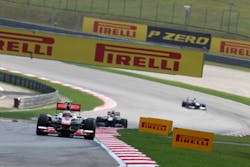Sepang is one of the toughest tracks of the year for the tires, because of the both the weather and track conditions. Pirelli is bringing the P Zero Silver hard and P Zero White medium tire to the Malaysian Grand Prix, as the Italian firm's motorsport director Paul Hembery will explain in a unique live chat that is available for streaming on your own website (details below).
Track temperatures in Malaysia can exceed 50 degrees centigrade during the hottest part of the day. The higher track temperatures and rougher surface should lead to a significantly higher wear rate than Melbourne, meaning that degradation is more severe. This is the thinking behind the nomination of the hard and medium tires for the first time. The other key point is the high lateral demands imposed by the circuit, with the most challenging sequence of corners being turns five to seven and turns 12 to 13 – as we can see when we look at the track from a tire’s point of view.
During the entry to turn one, 460 meters after the start-finish line, the front tires have to provide both braking and steering – which becomes critical in the middle of the corner due to the low speed and consequent lack of aerodynamic downforce. Traction is particularly important for turn two, as it leads into a high-speed section so a good exit is required.
Through the fast corners of the circuit (two of them are taken at speeds higher than 250kph) the tires have to cope with lateral forces of up to 4G that place heavy demands on the shoulder: the part of the tire where the most heat tends to build up. A driver needs plenty of stability from the tires throughout turn three in particular. Turns five and six are also fast: the car can be run low with a stiff suspension set-up as there are no big kerbs in Sepang. As always, the tires form a vital part of the car’s suspension, absorbing any bumps and imperfections on the track.
The final corner – turn 15 – takes in a deceleration of 5.3G. All the braking is done in a straight line to maximize braking efficiency. Then the driver turns into the corner at speed, with the external tire absorbing all the force of both thelateral and longitudinal accelerations. The entry to this corner usually provides a good opportunity for overtaking, thanks also to the use of KERS and DRS, and drivers often take a variety of lines here.
The Cinturato wet weather tires in Malaysia:
The Malaysian Grand Prix is one of the hottest and most demanding events of the year for the tires, which is why Pirelli has nominated the hard and medium slick tires for Sepang – but this is only half the story.
The 80% humidity that is a constant feature of the area frequently results in heavy rain, although unusually all the on-track running was dry last year. So Pirelli’s new Cinturato Green intermediate and Cinturato Blue full wet tire – seen for the first time on Friday in Australia – is likely to play an important role this weekend.
The 2012-specification Cinturato rear wet-weather tires are an evolution of the rain tires seen last year, with a new profile, while the compounds and tread patterns remain largely the same. The effect of these changes has been to enhance both performance and safety in wet conditions.
Both the intermediate and full wet tires continue to offer high levels of protection against aquaplaning, with the intermediate capable of dispersing around 25 liters of water per second at full speed, while the full wet can disperse up to 60 liters of water.
When it comes to the slick tires, the new ‘squarer’ profile distributes all the forces more evenly across the whole surface of the tire. This provides another important advantage in terms of safety. On the straights, the contact patch now measures 300 centimeters squared – providing the grip, traction and turn-in that is essential for a driver to maintain perfect control even at the limit of performance.
The levels of lateral energy that the tires have to cope with in Malaysia is the second highest of the year after Barcelona – with the rear tires coming under particular stress – and that applies equally to the wet and the dry compounds.
Whenever it rains in Sepang, the track tends to dry up quite quickly but it does not drain particularly well. This leads to plenty of standing water that can catch drivers out even when there appears to be a dry line.
Live online chat with Paul Hembery
Paul Hembery will be taking part in a live online chat from the Malaysian Grand Prix on Saturday at 7.30pm local time (+7 hours from Italy). To join in and stream this chat onyour own website please visit: http://streamingf1.pirelli.com/share/
Latest in Retail
Latest in Retail



